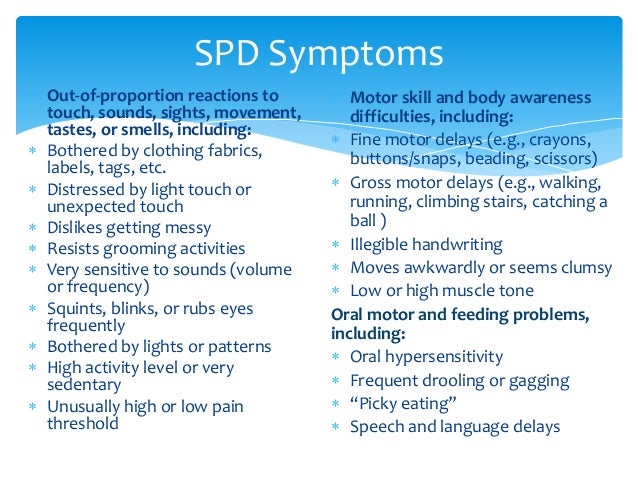
Understanding sensory processing issues.Understanding sensory processing disorder.You can learn more about how we ensure our content is accurate and current by reading our editorial policy. We link primary sources - including studies, scientific references, and statistics - within each article and also list them in the resources section at the bottom of our articles. Medical News Today has strict sourcing guidelines and draws only from peer-reviewed studies, academic research institutions, and medical journals and associations. For example, some people may experience difficulties telling the difference between textures. In some cases, the symptoms are more subtle. For example, some symptoms affect movement and balance. Many other symptoms can also occur, depending on which senses the disorders affect. frequently touch objects and play roughly.Those who are undersensitive to sensory input may: reacting strongly to smells, sounds, or textures.This typically results in over or undersensitivity to sensations.įor example, some will experience fewer sensations than normal, while others will become easily overwhelmed.Ĭhildren who find sensory input overwhelming may show signs that include:

They can also have trouble processing or be easily overwhelmed by other senses, including vestibular senses (head movements), proprioception (muscle and joint movement), and interception. The main symptom of a sensory processing disorder in children and adults is the inappropriate processing of sensory information. People with sensory processing disorder can be overwhelmed by any of the five senses that most people are familiar with: touch, taste, sound, sight, or smell. The disorders typically start when a person is a toddler. Others may lack sensations, causing them to play roughly and constantly touch objects. Others may become undersensitive to sensory input.įor example, children with a sensory processing disorder may find certain places or people overwhelming. Some people become oversensitive to sensory input. The sounds of people talking loudly, strong smells of food, and flickering fluorescent lights can all trigger feelings of being overwhelmed and uncomfortable. Also known as Sensory Integration Dysfunction, this disorder. The disorders cause inappropriate responses, reactions, or both to sensory information. For example, a child with SPD can be extremely sensitive to sound, smell, or tactile sensation. People usually have no difficulties receiving the information itself. When a person has a sensory processing disorder, their brain cannot effectively process certain sensory information. interoception, which refers to needing the toilet or feeling hungry.The brain then processes these sound waves, turning them into something meaningful. It receives information about the outside world through sensory inputs.įor example, the ears receive sensory information in the form of sound waves. The nervous system is a complex system of nerve cells that send signals around the body.

Sensory processing disorders disrupt how the nervous system processes sensory information. Share on Pinterest The symptoms of sensory processing disorders may start at a young age.


 0 kommentar(er)
0 kommentar(er)
